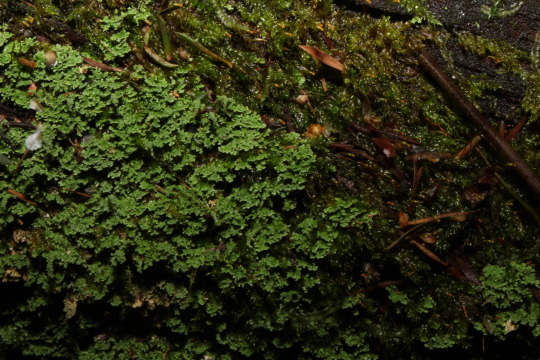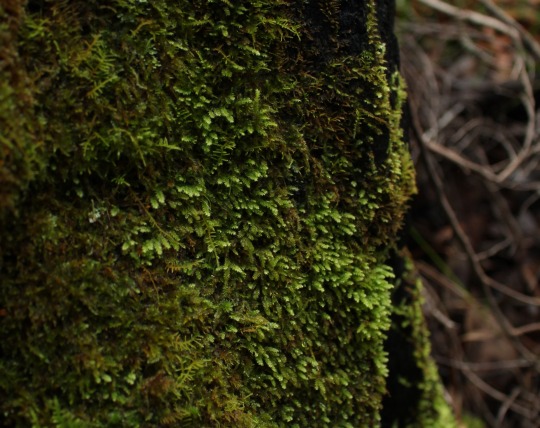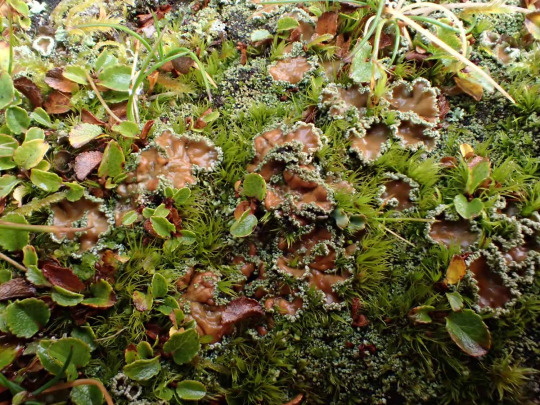#lichenised fungi
Explore tagged Tumblr posts
Text
FOTD #086 : christmas wreath lichen! (cryptothecia rubrocincta)
the christmas wreath lichen is a fungus from the family arthoniaceae. the lichen is found in subtropical & tropical areas throughout the south-eastern US, as well as central & south america. it has even been collected a few times in africa :-)
the big question : can i bite it?? i cannot find any info on this !! it is at least not poisonous.


c. rubrocincta description :
"the body of the lichen forms continuous, circular crust-like patches on dead wood, readily recognizable by the prominent red pigment. the older, central region is covered with red, spherical to cylindrical granules. moving outwards from the centre, zones of colour may be distinguished, the first grey-green, the second white, & finally a bright red cottony rim. the red & green colours of this unmistakable woodland lichen give the appearance of a christmas wreath."
[images : source & source] [fungus description : source]
"i was thinking of saving this for christmas, but it's so pretty !! i just couldn't wait. it's been a while since i did a lichen. :-)"
#• fungus of the day !! •#[cryptothecia rubrocincta]#: christmas lichen :#: christmas wreath lichen :#086#||#mycology#mushroom#nature#mushrooms#earth#cottagecore#forestcore#fungus#foraging#fungi#lichen#lichenised fungi#fotd#fungus of the day#cryptothecia rubrocincta#christmas wreath lichen#christmas lichen
57 notes
·
View notes
Photo






Convergent geometry in unrelated photosynethics in shadey habitats Lichen: 1: Liverworts: 2, 3, 4 Moss: 5, 6 I love the way these grow.
Layered horizonal shingles/scales like balconies or terraces? How commonly unrelated organisms evolve this kinda design indicates it’s highly effective for shadey damp slopes/walls, you can see this everywhere after you start to look. ferns on cliffs, epiphtyes on trees, an alien world would definately have these shapes. I wonder what the forces that are at work are? Which combinations dominate to produce this shape?
the most obvious are the ones perpendicular to the plane they grow on. The light source is up, gravity is down. you can see that on the edges of these shinglescales theres a curvature downwards, perhaps the limiting factor for the radius of the protrusion is the strength against gravity? you don’t want to grow long if your ends do not face sun? but the light here is very diffuse so maybe it’s not sun? the fissidens (pocket moss) in particular loves overhangs where theres rock between the top of the leaf and the sun,,, is bouncey light from below a factor?
The fingerworts fascinate me (below)

they are leafy liverworts, they have terete (circular in cross section perpendicular to length) stem thingo with little clawed hand looking leaf structures down itthier length. microscopically they are beautiful and look like a kinda weird seaweed or coral. macroscopically (naked eye) you cannot see the leaves, you can only just make out the branchedness if you are super close, leaves can look like a ultra thin light green fuzz over the surface when dry, when wet the water film holds the whole thing together like a single angluar leaflet/scale, the water tension holes the branches together. I love how despite it;’s microscopic structure being so completely different, when wet (which it often is due to habitat preferences|) it has the same 3rd profile as the lichens and moss and thalose liverworts. Lichen are already always bizzare and more absurd than any organism, I often think that, if I did not see them so often, I would think they were a joke or prank. A fake taxa. fungi and photosymbionts growing together would be frustrating outliers if we still believed life was an organised Grand Plan.many different fungi and photosymbionts independantly deciding to try out lichenisation and then converging on similar plans is a testament to how powerfully successful such an accidental partnership is. I always maintain that if someone wishes to design an alein ecosystem, and make a convincing alien world, they need only to make it out of existing lichen. scale up some cladia repitroa (below)

and you have an alien biota that people will say “that’s impossible/plausible, unconvicing, no living organism could exist like that in reality!” and then you refer them to that it does infact exist. The conventions used in science fiction and speculative biology are lazy and boring, so often are the same tired pine trees with red leaves trotted out, or giant mushrooms, a single lignified trunk is a painful thing to see., pines and dicots have it, do you think an alien planet has pines and dicots? Cycads, Xanthorhea, Yucca, Kingia, Palms, treeferns, these are the way a short small plant figures out how to big and tall, they all did it by themselves! this shows the design is good! one that a speculative organism may chance upon and bolt upon!. Kelp, darwinia, horsetails, these are also how you can get tall, even acuariaceae (admittedly one of the pinophytes) knows how to have a more interesting central support than most speculative trees.
Prototaxites

the first large organism on land, a fungus, likley lichen.
6 notes
·
View notes
Photo

'#Brussels , which occupies 161 km2, and located in the centre of #Belgium , is situated in an area of different biogeographical influences where species of Atlantic and medio-European origins grow together. The flora has taken advantage of this heterogeneity of mosaics by developing a higher diversity than that of the adjacent areas. A total of 730 plant species have been recorded in the city, which represents half of the Belgian #flora . The bryoflora comprise 225 species, of which 40 are hepatics and 185 are mosses; they represent about 33% of the Belgian bryoflora. 1306 species of fungi and 86 lichenised fungi have been recorded in the city so far. Nine important EU-habitats are present, mainly in three Special Areas of Conservation that cover a total of 1,900 ha (12% of the city). Current strategies for nature development are based on three different actions: (1) the increase in total surfaces of green spaces, (2) the increase in ecological quality of green spaces and (3) the development of ecological networks. The diversity of various taxonomic groups and habitats is particularly well monitored providing a #biological database that has been integrated into and provides for the effective planning, design and management of the city’s environment.' ---- <Brussels>, author: madame Sandrine Godefroid. https://www.researchgate.net/publication/302508983_Brussels https://www.instagram.com/p/CPTK8amhkg_/?utm_medium=tumblr
0 notes
Text
FOTD #117 : bowl lichen! (psoroma genus)
the bowl lichens are lichenised fungi belonging to the family pannariaceae. they occur across the world & are often found in south temperate regions :-) these lichen typically grow in association with mosses on a variety of substrates !! there is little else currently known about them.
the big question : can i bite it?? i could not find any information on this, but this lichen is not listed as poisonous anywhere on the internet currently.


[images : source & source] [fungus description : i could not find one !! :-/]
#• fungus of the day !! •#[psoroma genus]#[psoroma hypnorum]#117#||#mycology#mushrooms#mushroom#earth#cottagecore#foraging#forestcore#nature#fungi#fungus#lichen#fotd#lichenized fungi#fungus of the day#undescribed#image undescribed
156 notes
·
View notes